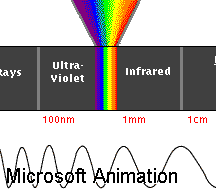
| |
 |
![]()
 From the difference between a wide Spectrum and a full Spectrum light?
From the difference between a wide Spectrum and a full Spectrum light?
It used to be that 'full spectrum' lighting meant lights which produced both ultraviolet B, ultraviolet A and the full visible spectrum as well infrared heat. Once incandescent manufacturers figured out that people were being told to look for 'full spectrum' lighting, they started to market their wide spectrum (producing some, but not all of the visible wavelengths and no ultraviolet wavelengths) lights with 'full spectrum' in the ads and on packaging. Thus people are buying Chromalux, NeoWhite and Reptile incandescent lights thought, incorrectly, that they are providing UVB, UVA and full visible wavelengths to their reptiles. In fact, incandescents are just producing, if they are putting out bright white light, only the visible spectrum; some which produce colored light, are not necessarily even producing the full visible spectrum, being corrected to increase or reduce certain parts of that spectrum.
Fluorescent light manufacturers weren't slow to get on this bandwagon, either - unfortunately, not all fluorescents produce UVB wavelengths, either ...
From the Myth of Full Spectrum Lighting.
Q. When customers ask for "Full Spectrum Lighting," what should I tell them?
A. Tell your customer that there is no such thing. The myth about the healing powers of "Full Spectrum Lighting" simply refuses to die. It all began in the early 60s when a small lighting manufacturer devised a clever marketing gimmick. Claiming that its product featured "Full Spectrum Lighting," the manufacturer advertised that the lamp not only "brought sunlight indoors," but also cured a variety of ills ranging from Seasonal Affective Disorder (SAD) to a less-than-lusty sex life. This marketing campaign undoubtedly made a strong impression on many, especially the Federal Drug Administration (FDA) who issued a charge of health fraud in 1986. Knowing that there was no way they could support their claims, the manufacturer retracted the claims immediately. Although this happened ten years ago, many people, from holistic healers to ordinary shoppers, still believe in the healing powers of "Full Spectrum Lighting." Through very successful advertising without one iota of truth, the myth of "Full Spectrum Lighting" lives on.
FYI: All light sources cover the visible spectrum, they just peak at different points. Depending on the color temperature of a light source, measured in Kelvin or "K," a customer can choose a warm (3000K), a neutral (3500K) or a cool (4100K) color appearance depending on how he or she plans to use the lamp.
That myth is pure garbage. Lighting industry propaganda. Full Spectrum lighting is vastly superior for biological systems than ordinary lighting. Read Jonathan Ott's book: Light, Radiation, and You (1982/1990). Tons of research data and experiments that prove the point.